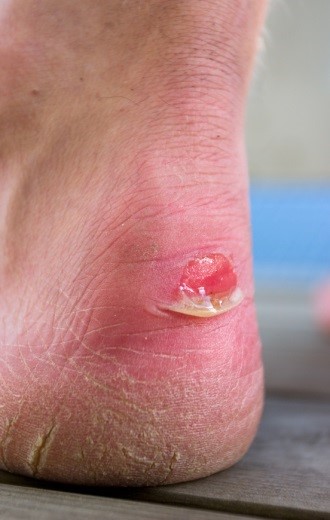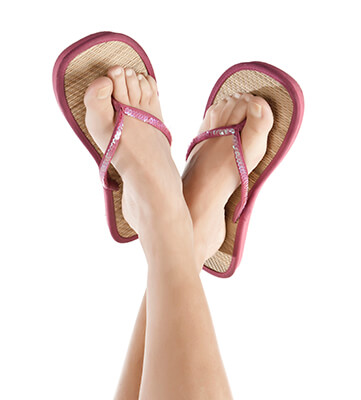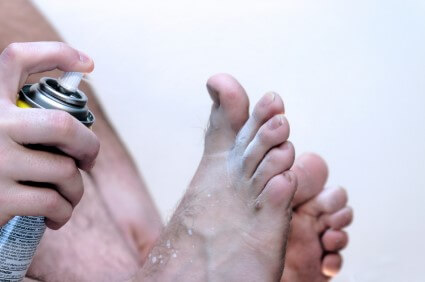 Blisters are a fairly common foot condition that can be easily prevented with a few simple steps. The first step is to always ensure the feet or kept clean to prevent any germs or bacteria from penetrating the skin. Wearing the right pair of socks can also help support the feet and reduce friction, which can create blisters. Applying bandages or band aids to any preexisting blisters can help reduce excess heat or additional friction that can exacerbate the blister.
Blisters are a fairly common foot condition that can be easily prevented with a few simple steps. The first step is to always ensure the feet or kept clean to prevent any germs or bacteria from penetrating the skin. Wearing the right pair of socks can also help support the feet and reduce friction, which can create blisters. Applying bandages or band aids to any preexisting blisters can help reduce excess heat or additional friction that can exacerbate the blister.
Blisters are prone to making everyday activities extremely uncomfortable. If your feet are hurting, contact Dr. Mark Quist from Carolina Foot & Ankle Specialists. Dr. Quistwill assist you with all of your podiatric concerns.
Foot Blisters
Foot blisters develop as a result of constantly wearing tight or ill-fitting footwear. This happens due to the constant rubbing from the shoe, which can often lead to pain.
What are Foot Blisters?
A foot blister is a small fluid-filled pocket that forms on the upper-most layer of the skin. Blisters are filled with clear fluid and can lead to blood drainage or pus if the area becomes infected.
How do Blisters Form?
Blisters on the feet are often the result of constant friction of skin and material, usually by shoe rubbing. Walking in sandals, boots, or shoes that don’t fit properly for long periods of time can result in a blister. Having consistent foot moisture and humidity can easily lead to blister formation.
Prevention & Treatment
It is important to properly care for the affected area in order to prevent infection and ease the pain. Do not lance the blister and use a Band-Aid to provide pain relief. Also, be sure to keep your feet dry and wear proper fitting shoes. If you see blood or pus in a blister, seek assistance from a podiatrist.
If you have any questions please contact our offices located in Mooresville and Mountain Island, NC. We offer the newest diagnostic and treatment technologies for all your foot and ankle needs.
Read more about blisters on the feet
 Rheumatoid arthritis is an autoimmune disorder, or a condition in which the body attacks itself. Bacteria in the gut have been found to predict susceptibility of rheumatoid arthritis. Experts were able to study microbes that were normally low in healthy individuals, but high in people with rheumatoid arthritis. This study could be used to predict if someone is likely to have rheumatoid arthritis in the future.
Rheumatoid arthritis is an autoimmune disorder, or a condition in which the body attacks itself. Bacteria in the gut have been found to predict susceptibility of rheumatoid arthritis. Experts were able to study microbes that were normally low in healthy individuals, but high in people with rheumatoid arthritis. This study could be used to predict if someone is likely to have rheumatoid arthritis in the future.
Because RA affects more than just your joints, including the joints in your feet and ankles, it is important to seek early diagnosis from your podiatrist if you feel like the pain in your feet might be caused by RA. For more information, contact Dr. Mark Quist from Carolina Foot & Ankle Specialists. Dr. Quist can provide the care you need to keep your pain free and on your feet.
What Is Rheumatoid Arthritis?
Rheumatoid Arthritis (RA) is an autoimmune disorder in which the body’s own immune system attacks the membranes surrounding the joints. Inflammation of the lining and eventually the destruction of the joint’s cartilage and bone occur, causing severe pain and immobility.
Rheumatoid Arthritis of the Feet
Although RA usually attacks multiple bones and joints throughout the entire body, almost 90 percent of cases result in pain in the foot or ankle area.
Symptoms
- Swelling & pain in the feet
- Stiffness in the feet
- Pain on the ball or sole of feet
- Joint shift and deformation
Diagnosis
Quick diagnosis of RA in the feet is important so that the podiatrist can treat the area effectively. Your doctor will ask you about your medical history, occupation, and lifestyle to determine the origin of the condition. Rheumatoid Factor tests help to determine if someone is affected by the disease.
If you have any questions, please feel free to contact our offices located in Mooresville and Mountain Island, NC. We offer the newest diagnostic and treatment technologies for all your foot care needs.
Read more on Rheumatoid Arthritis
 When the tendon at the bottom of the foot becomes inflamed and painful, plantar fasciitis occurs. There are risk factors that may make you more susceptible to getting plantar fasciitis. Some of these factors include being a female and being overweight. If your job requires you to stand for long periods of time on a hard surface, you are also more likely to have plantar fasciitis. Another group of people who are at risk for the condition are those who walk or run long distances on a regular basis.
When the tendon at the bottom of the foot becomes inflamed and painful, plantar fasciitis occurs. There are risk factors that may make you more susceptible to getting plantar fasciitis. Some of these factors include being a female and being overweight. If your job requires you to stand for long periods of time on a hard surface, you are also more likely to have plantar fasciitis. Another group of people who are at risk for the condition are those who walk or run long distances on a regular basis.
Plantar fasciitis can be very painful and inconvenient. If you are experiencing heel pain or symptoms of plantar fasciitis, contact Dr. Mark Quist from Carolina Foot & Ankle Specialists. Dr. Quistcan provide the care you need to keep your pain free and on your feet.
What is Plantar Fasciitis?
Plantar fasciitis is the inflammation of the thick band of tissue that runs along the bottom of your foot, known as the plantar fascia, and causes mild to severe heel pain.
What Causes Plantar Fasciitis?
· Excessive running
· Non-supportive shoes
· Overpronation
· Repeated stretching and tearing of the plantar fascia
How Can It Be Treated?
· Conservative measures – anti-inflammatories, ice packs, stretching exercises, physical therapy, orthotic devices
· Shockwave therapy – sound waves are sent to the affected area to facilitate healing and are usually used for chronic cases of plantar fasciitis
· Surgery – usually only used as a last resort when all else fails. The plantar fascia can be surgically detached from the heel
While very treatable, plantar fasciitis is definitely not something that should be ignored. Especially in severe cases, speaking to your doctor right away is highly recommended to avoid complications and severe heel pain. Your podiatrist can work with you to provide the appropriate treatment options tailored to your condition.
If you have any questions please feel free to contact our office located in Mooresville and Mountain Island, NC. We offer the newest diagnostic tools and technology to treat your foot and ankle needs.
 People often buy flip-flops with little knowledge on how they may affect your feet. Flip-flops do not offer much support for your feet, and they may cause plantar fasciitis. Wearing flip-flops also causes your toes to contract, which can cause hammertoe. When shopping for flip-flops you should look for durability, quality, and comfort. Heavy-duty flip flops that are made of soft leather instead of foam last extremely long and provide a lot of comfort. Thicker straps are also best when it comes to flip flops, because thin straps cut into the skin during aggressive activity.
People often buy flip-flops with little knowledge on how they may affect your feet. Flip-flops do not offer much support for your feet, and they may cause plantar fasciitis. Wearing flip-flops also causes your toes to contract, which can cause hammertoe. When shopping for flip-flops you should look for durability, quality, and comfort. Heavy-duty flip flops that are made of soft leather instead of foam last extremely long and provide a lot of comfort. Thicker straps are also best when it comes to flip flops, because thin straps cut into the skin during aggressive activity.
Flip-flops are not always the best choice of footwear. If you are seeking treatment, contact Dr. Mark Quist from Carolina Foot & Ankle Specialists. Dr. Quistwill assist you with all of your foot and ankle needs.
Flip-Flops and Feet
When the weather starts warming up, people enjoy wearing flip-flops. Flip-flops are comfortable, stylish, and easy to slip on and off, perfect for any summer beach goer. However, these shoes can cause harm to the feet.
How Can Flip-Flops Affect Me Long-Term?
Are there injuries associated with flip-flops?
Yes. Since flip-flops are relatively weak and do not provide the same amount of support as sneakers, people who wear flip-flops are more susceptible to injuries. On top of that, the open nature of the shoe makes your feet more prone to other problems, such as cuts and even infections. Common injuries and ailments include:
I like wearing flip-flops, are there safe alternatives?
When buying flip-flops, try to find ones that have sturdy soles and are made of high quality materials that will support for your feet. These flip-flops will cost more, but will also last longer as a result.
If you have any questions, please feel free to contact our office located in Mooresville and Mountain Island, NC. We offer the newest diagnostic and treatment technologies for all your foot and ankle needs.
Read more about Flip-Flops and Your Feet
 Feet tend to sweat more in the summer, and they also become more susceptible to infections such as Athlete’s foot. Athlete’s foot is a fungal infection that makes feet dry, flaky, and itchy. A simple treatment for Athlete’s foot is to moisturize your feet with urea cream. When you moisturize your feet, you should avoid putting moisturizer between your toes. You should focus on your heels and balls of your foot when applying moisturizer.
Feet tend to sweat more in the summer, and they also become more susceptible to infections such as Athlete’s foot. Athlete’s foot is a fungal infection that makes feet dry, flaky, and itchy. A simple treatment for Athlete’s foot is to moisturize your feet with urea cream. When you moisturize your feet, you should avoid putting moisturizer between your toes. You should focus on your heels and balls of your foot when applying moisturizer.
Athlete’s foot is an inconvenient condition that can be easily reduced with the proper treatment. If you have any concerns about your feet and ankles contact Dr. Mark Quist from Carolina Foot & Ankle Specialists. Dr. Quistwill treat your foot and ankle needs.
Athlete’s Foot: The Sole Story
Athlete's foot, also known as tinea pedis, can be an extremely contagious foot infection. It is commonly contracted in public changing areas and bathrooms, dormitory style living quarters, around locker rooms and public swimming pools, or anywhere your feet often come into contact with other people.
Solutions to Combat Athlete’s Foot
Athlete’s foot can cause many irritating symptoms such as dry and flaking skin, itching, and redness. Some more severe symptoms can include bleeding and cracked skin, intense itching and burning and even pain when walking. In the worst cases, athlete’s foot can cause blistering as well. Speak to your podiatrist for a better understanding of the different causes of athlete’s foot, as well as helping you figure out which treatment options are best for you.
If you have any questions, please feel free to contact our office in Mooresville and Mountain Island, NC. We offer the newest diagnostic and treatment technologies for all your foot care needs.